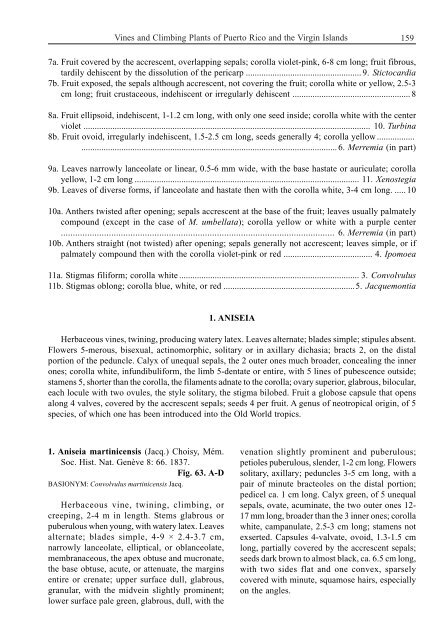Vines and Climbing Plants of Puerto Rico and the Virgin Islands
Vines and Climbing Plants of Puerto Rico and the Virgin Islands
Vines and Climbing Plants of Puerto Rico and the Virgin Islands
You also want an ePaper? Increase the reach of your titles
YUMPU automatically turns print PDFs into web optimized ePapers that Google loves.
<strong>Vines</strong> <strong>and</strong> <strong>Climbing</strong> <strong>Plants</strong> <strong>of</strong> <strong>Puerto</strong> <strong>Rico</strong> <strong>and</strong> <strong>the</strong> <strong>Virgin</strong> Isl<strong>and</strong>s 159<br />
7a. Fruit covered by <strong>the</strong> accrescent, overlapping sepals; corolla violet-pink, 6-8 cm long; fruit fibrous,<br />
tardily dehiscent by <strong>the</strong> dissolution <strong>of</strong> <strong>the</strong> pericarp .................................................... 9. Stictocardia<br />
7b. Fruit exposed, <strong>the</strong> sepals although accrescent, not covering <strong>the</strong> fruit; corolla white or yellow, 2.5-3<br />
cm long; fruit crustaceous, indehiscent or irregularly dehiscent ..................................................... 8<br />
8a. Fruit ellipsoid, indehiscent, 1-1.2 cm long, with only one seed inside; corolla white with <strong>the</strong> center<br />
violet ................................................................................................................................. 10. Turbina<br />
8b. Fruit ovoid, irregularly indehiscent, 1.5-2.5 cm long, seeds generally 4; corolla yellow .................<br />
................................................................................................................... 6. Merremia (in part)<br />
9a. Leaves narrowly lanceolate or linear, 0.5-6 mm wide, with <strong>the</strong> base hastate or auriculate; corolla<br />
yellow, 1-2 cm long ..................................................................................................... 11. Xenostegia<br />
9b. Leaves <strong>of</strong> diverse forms, if lanceolate <strong>and</strong> hastate <strong>the</strong>n with <strong>the</strong> corolla white, 3-4 cm long. ..... 10<br />
10a. An<strong>the</strong>rs twisted after opening; sepals accrescent at <strong>the</strong> base <strong>of</strong> <strong>the</strong> fruit; leaves usually palmately<br />
compound (except in <strong>the</strong> case <strong>of</strong> M. umbellata); corolla yellow or white with a purple center<br />
.................................................................................................................. 6. Merremia (in part)<br />
10b. An<strong>the</strong>rs straight (not twisted) after opening; sepals generally not accrescent; leaves simple, or if<br />
palmately compound <strong>the</strong>n with <strong>the</strong> corolla violet-pink or red ........................................ 4. Ipomoea<br />
11a. Stigmas filiform; corolla white ................................................................................. 3. Convolvulus<br />
11b. Stigmas oblong; corolla blue, white, or red ...........................................................5. Jacquemontia<br />
1. ANISEIA<br />
Herbaceous vines, twining, producing watery latex. Leaves alternate; blades simple; stipules absent.<br />
Flowers 5-merous, bisexual, actinomorphic, solitary or in axillary dichasia; bracts 2, on <strong>the</strong> distal<br />
portion <strong>of</strong> <strong>the</strong> peduncle. Calyx <strong>of</strong> unequal sepals, <strong>the</strong> 2 outer ones much broader, concealing <strong>the</strong> inner<br />
ones; corolla white, infundibuliform, <strong>the</strong> limb 5-dentate or entire, with 5 lines <strong>of</strong> pubescence outside;<br />
stamens 5, shorter than <strong>the</strong> corolla, <strong>the</strong> filaments adnate to <strong>the</strong> corolla; ovary superior, glabrous, bilocular,<br />
each locule with two ovules, <strong>the</strong> style solitary, <strong>the</strong> stigma bilobed. Fruit a globose capsule that opens<br />
along 4 valves, covered by <strong>the</strong> accrescent sepals; seeds 4 per fruit. A genus <strong>of</strong> neotropical origin, <strong>of</strong> 5<br />
species, <strong>of</strong> which one has been introduced into <strong>the</strong> Old World tropics.<br />
1. Aniseia martinicensis (Jacq.) Choisy, Mém.<br />
Soc. Hist. Nat. Genève 8: 66. 1837.<br />
Fig. 63. A-D<br />
BASIONYM: Convolvulus martinicensis Jacq.<br />
Herbaceous vine, twining, climbing, or<br />
creeping, 2-4 m in length. Stems glabrous or<br />
puberulous when young, with watery latex. Leaves<br />
alternate; blades simple, 4-9 × 2.4-3.7 cm,<br />
narrowly lanceolate, elliptical, or oblanceolate,<br />
membranaceous, <strong>the</strong> apex obtuse <strong>and</strong> mucronate,<br />
<strong>the</strong> base obtuse, acute, or attenuate, <strong>the</strong> margins<br />
entire or crenate; upper surface dull, glabrous,<br />
granular, with <strong>the</strong> midvein slightly prominent;<br />
lower surface pale green, glabrous, dull, with <strong>the</strong><br />
venation slightly prominent <strong>and</strong> puberulous;<br />
petioles puberulous, slender, 1-2 cm long. Flowers<br />
solitary, axillary; peduncles 3-5 cm long, with a<br />
pair <strong>of</strong> minute bracteoles on <strong>the</strong> distal portion;<br />
pedicel ca. 1 cm long. Calyx green, <strong>of</strong> 5 unequal<br />
sepals, ovate, acuminate, <strong>the</strong> two outer ones 12-<br />
17 mm long, broader than <strong>the</strong> 3 inner ones; corolla<br />
white, campanulate, 2.5-3 cm long; stamens not<br />
exserted. Capsules 4-valvate, ovoid, 1.3-1.5 cm<br />
long, partially covered by <strong>the</strong> accrescent sepals;<br />
seeds dark brown to almost black, ca. 6.5 cm long,<br />
with two sides flat <strong>and</strong> one convex, sparsely<br />
covered with minute, squamose hairs, especially<br />
on <strong>the</strong> angles.
















